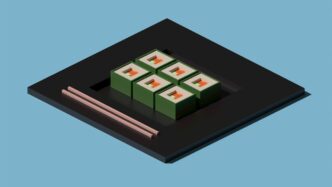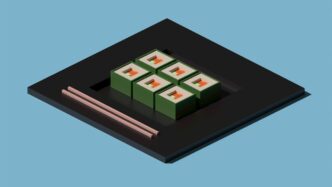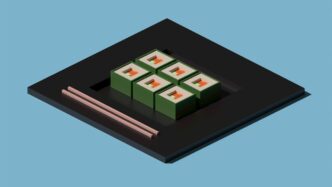So, you’re looking to get a handle on quantum mechanics, huh? It’s a bit of a beast, not gonna lie. But the good news is, working through problems is really the best way to start making sense of it all. We’re going to break down some quantum mechanics practice problems, covering the basics and then moving into more involved stuff. Think of this as your guide to tackling those tricky concepts. We’ll look at how the Schrödinger equation works, what it means for particles in different situations, and even touch on how quantum mechanics is used today. It’s all about building that problem-solving muscle.
Key Takeaways
- Understanding the core ideas of quantum mechanics, like how equations behave and why things aren’t always predictable, is the first step. This involves looking at how quantum mechanics is different from older physics.
- The Schrödinger equation is central to figuring out how quantum systems change over time. Practicing with this equation for different scenarios, like particles stuck in boxes or moving freely, is super important.
- Getting familiar with operators, what they represent, and how they work together is key for advanced quantum mechanics. This includes understanding when you can measure multiple things at once.
- Learning about the different ways to view how quantum systems evolve, like the Schrödinger picture and the Heisenberg picture, helps in solving problems and understanding the physics.
- Applying quantum mechanics to specific systems, such as the harmonic oscillator or spin systems, and exploring modern uses like quantum computation, shows the real-world impact and complexity of the field.
Foundational Quantum Mechanics Practice Problems
Alright, let’s get down to the nitty-gritty of quantum mechanics. Before we start tackling complex systems, we need to make sure our footing is solid on the basics. This section is all about those core ideas that make quantum mechanics so different from the physics we see every day. Think of it as building the foundation for everything else we’ll cover.
Key Features of Quantum Mechanics
Quantum mechanics is weird, plain and simple. It doesn’t always follow our gut feelings about how the world should work. One of the biggest shifts is how we think about measurement. In classical physics, measuring something doesn’t really change it, or at least, we can account for that change. In quantum mechanics, the act of measuring can fundamentally alter the state of the system you’re looking at. This observer effect is a big deal. It’s not just about having clumsy instruments; it’s built into the fabric of how quantum systems behave.
Here are a few things that really set quantum mechanics apart:
- Quantization: Many physical properties, like energy or angular momentum, don’t come in a continuous range. Instead, they exist only in discrete packets, or ‘quanta’. Think of it like a light switch that can only be fully on or fully off, not somewhere in between.
- Wave-Particle Duality: Tiny things like electrons can act like both waves and particles. Depending on how you set up your experiment, you’ll see one behavior or the other, but never both at the same time in the same way.
- Probabilistic Nature: We can’t always predict the exact outcome of a measurement. Instead, quantum mechanics gives us probabilities for different outcomes. It’s like rolling dice; you know the chances of getting a certain number, but you can’t be sure until you roll.
Linearity of the Equations of Motion
This might sound a bit technical, but linearity is super important. It means that if you have two possible solutions to a quantum mechanical equation, then any combination of those solutions is also a valid solution. This property is what allows for superposition, a concept where a quantum system can be in multiple states at once until it’s measured. It’s a direct consequence of the mathematical framework used to describe these systems.
Complex Numbers Are Essential
Yep, you’re going to need to get comfortable with imaginary numbers and complex numbers. They aren’t just a mathematical trick; they are absolutely necessary to describe quantum states. The wave function, which is our main tool for understanding quantum systems, is inherently a complex-valued function. The probabilities we talked about earlier come from the square of the magnitude of this complex wave function, which is always a real, positive number. So, while the underlying description uses complex numbers, the observable outcomes are real.
Loss of Determinism
This is the flip side of the probabilistic nature. In classical mechanics, if you know the exact position and momentum of an object at one moment, you can predict its exact future trajectory. Quantum mechanics throws that out the window. Because of the probabilistic nature and the uncertainty principle (which we’ll get to), we can’t know both position and momentum with perfect accuracy simultaneously. This means we can only predict the likelihood of future events, not their certainty. It’s a fundamental departure from how we usually think about cause and effect.
Solving Quantum Mechanics Problems with the Schrödinger Equation
Alright, let’s get down to business with the Schrödinger equation. This is where the rubber meets the road in quantum mechanics, giving us the tools to actually figure out what these tiny particles are up to. It’s the central equation that describes how the quantum state of a physical system changes over time. Think of it as the fundamental law of motion for quantum stuff.
The Schrödinger Equation
So, what is this equation? In its most basic form, it looks like this:
iħ ∂Ψ/∂t = ĤΨ
Don’t let the symbols scare you. i is the imaginary unit, ħ (h-bar) is the reduced Planck constant, ∂Ψ/∂t is how the wave function Ψ changes with time, and Ĥ is the Hamiltonian operator. The Hamiltonian represents the total energy of the system – kinetic plus potential. The Schrödinger equation tells us how the wave function, which contains all the information about a quantum system, evolves. It’s the heart of quantum mechanics, and understanding it is key to solving problems. You can find more about the Schrödinger equation and wave functions if you need a refresher.
Energy Eigenstates of Particles in Potentials
When we’re dealing with systems where the potential energy doesn’t change over time (time-independent potentials), we can simplify things a lot. We look for solutions called energy eigenstates. These are special states where the energy of the particle is definite. The equation for these states is:
ĤΨ = EΨ
Here, E is the energy of the state, and Ψ is the corresponding energy eigenstate. Solving this equation for different potentials is a major part of quantum mechanics practice. For example, consider a particle trapped in a box. The solutions give us discrete energy levels, meaning the particle can only have certain specific energies, not just any energy value.
Here’s a quick look at what we might find for a particle in a 1D box:
| Quantum Number (n) | Energy (E_n) |
|---|---|
| 1 | E_1 |
| 2 | 4*E_1 |
| 3 | 9*E_1 |
This quantization of energy is one of the weirdest and most important ideas in quantum mechanics.
Free Particle on a Circle
Let’s take it a step further. Imagine a particle that’s not confined to a box but can move freely on a circle. This means its potential energy is zero everywhere. The Hamiltonian is just the kinetic energy operator. When you solve the Schrödinger equation for this setup, you find that the particle’s momentum is quantized. It can only have specific values of momentum, which leads to specific energy levels. This is a simpler case, but it still shows the power of the Schrödinger equation in revealing quantized properties. It’s a good starting point for understanding more complex systems like atoms.
Advanced Quantum Mechanics Practice Problems
Alright, let’s get into some of the more involved stuff in quantum mechanics. We’re going to look at Hermitian operators, which are super important because they represent physical measurements. Think about it, when you measure something like position or momentum, you expect a real number as the answer, right? Well, Hermitian operators are the mathematical way quantum mechanics guarantees that. They have this neat property where their eigenvalues (the possible results of a measurement) are always real numbers. Plus, their eigenvectors are orthogonal, which is handy for building up states.
Hermitian Operators and Axioms
So, the axioms of quantum mechanics lay down the rules of the game. One of the big ones is that every observable quantity – like energy, spin, or momentum – is associated with a Hermitian operator. This isn’t just some arbitrary rule; it’s tied directly to the fact that measurement outcomes are real. We also need to talk about how these operators act on our quantum states, which are represented by vectors in a Hilbert space. It’s all about how these operators transform states and what information we can get from them. The eigenvalues of a Hermitian operator correspond to the possible results of measuring the observable it represents.
Simultaneous Diagonalization of Operators
Now, what happens when we have multiple observables we want to measure at the same time? This is where simultaneous diagonalization comes in. If two operators can be diagonalized by the same set of basis vectors, it means we can know the values of both observables precisely at the same time. This is directly related to whether the operators commute. If $[A, B] = 0$, then they can be simultaneously diagonalized. This is a big deal because it tells us which properties of a system can be known with certainty together.
Complete Set of Commuting Observables
Building on the last point, a complete set of commuting observables (CSCO) is a set of operators that all commute with each other and are enough to specify the state of a system uniquely. Think of it like a full set of coordinates. If you have a CSCO, you can determine the state of your system down to the last detail. For example, for a particle in 3D, the operators for $L_z$, $L^2$, and the Hamiltonian ($H$) might form a CSCO in certain situations. Knowing the eigenvalues for all operators in the set tells you everything you can know about the system simultaneously.
Quantum Mechanics Practice Problems: Dynamics and Pictures
Quantum systems change with time in ways that are both strange and predictable. In this part, we go through the main ways to describe the evolution of quantum states. Each approach—Schrödinger and Heisenberg—handles the story a little differently. Sharpening your intuition with these viewpoints is the goal, so let’s roll up our sleeves and work through the key ideas and some hands-on problems.
Schrödinger Picture and Unitary Time Evolution
In the Schrödinger picture, the state of the system changes with time, while operators are mostly fixed. What this means is you watch the actual quantum state’s evolution, with time-evolution handled by a unitary operator. Every quantum system’s time development is guided by this perspective.
Here’s what you need to remember when working in the Schrödinger picture:
- The time evolution of a quantum state $|\psi(t)\rangle$ is given by $|\psi(t)\rangle = U(t, t_0)|\psi(t_0)\rangle$.
- The unitary operator $U(t, t_0)$ is $e^{-iH(t-t_0)/\hbar}$ if the Hamiltonian $H$ is time-independent.
- The Schrödinger equation for a state vector is $i\hbar \frac{d}{dt}|\psi(t)\rangle = H|\psi(t)\rangle$.
Try solving this simple practice problem:
- If a system starts in the state $|\psi(0)\rangle$ with a known Hamiltonian $H$, find $|\psi(t)\rangle$ for later times.
- Show that the unitary time-evolution operator always preserves the total probability.
- Consider a two-level system (spin-1/2) in a magnetic field. Write down the time-dependent state vector.
Heisenberg Picture
The Heisenberg picture flips things around. Here, states stay fixed while the operators themselves pick up time dependence. It’s kind of quirky, but for certain problems, this view is way more efficient.
- Operators evolve according to $A_H(t) = U^(-1)(t, t_0) A_S U(t, t_0)$.
- The equation that tells you how an operator changes is $\frac{d}{dt} A_H (t) = \frac{i}{\hbar}[H, A_H (t)] + \left(\frac{\partial A_S}{\partial t}\right)_H$.
Common steps when working in the Heisenberg picture:
- Write the initial state and operator at $t_0$.
- Use the commutator with the Hamiltonian to get the time derivative of the operator.
- Solve for how the operator changes in time.
Practice problem:
- Given a free particle, find how $\hat{x}$ and $\hat{p}$ change with time in the Heisenberg picture.
- For a harmonic oscillator, compute how the creation and annihilation operators behave over time.
- If $A$ is an operator that commutes with $H$, what does that mean for its time evolution?
Heisenberg Equations of Motion
This is the quantum version of Newton’s second law. The Heisenberg equation of motion shows how quantum observables (operators) change over time.
Heisenberg’s equation is $\frac{dA}{dt} = \frac{i}{\hbar}[H, A] + \frac{\partial A}{\partial t}$, and it’s crucial for calculations in the Heisenberg picture.
Let’s spell out some important points about this equation:
- When $[H, A]=0$, the operator $A$ is a conserved quantity.
- For the position and momentum operators for a simple harmonic oscillator, you can recover the classic oscillating behavior.
- The partial time derivative $\frac{\partial A}{\partial t}$ matters for operators that depend on time explicitly.
Example table for commutators (for the simple harmonic oscillator):
| Operator ($A$) | $[H, A]$ | Consequence |
|---|---|---|
| $\hat{x}$ | $i\hbar \hat{p}/m$ | $\dot{\hat{x}} = \hat{p}/m$ |
| $\hat{p}$ | $-i\hbar m \omega^2 \hat{x}$ | $\dot{\hat{p}} = -m\omega^2 \hat{x}$ |
| $H$ | 0 | $H$ is conserved |
Practice problems:
- Compute $\dot{\hat{x}}$ and $\dot{\hat{p}}$ for a quantum harmonic oscillator.
- Show that the energy operator $H$ is conserved if it doesn’t depend on time.
- If the Hamiltonian depends explicitly on time, how does that change the conservation law?
By working through these problems, you’ll see how both pictures are different but connected. Try switching between them to see which feels more natural for the problem you’re solving.
Specific Systems in Quantum Mechanics Practice Problems
Alright, so we’ve covered the basics, the math, and how things change over time. Now, let’s get our hands dirty with some actual systems. This is where quantum mechanics stops being just abstract ideas and starts describing the world around us, or at least, the tiny bits of it.
Solving the Harmonic Oscillator
The harmonic oscillator is like the ‘hello world’ of quantum mechanics. It pops up everywhere, from molecules vibrating to light waves. The math can get a bit involved, but there are some neat tricks.
- The energy levels are spaced out evenly. Unlike some other systems where the gaps between energy levels get smaller, here they’re all the same size. This is a big deal.
- We can solve this using a few methods. One way is to just solve the Schrödinger equation directly, which gives you a bunch of differential equations to wrestle with. Another, often easier, way is using something called ladder operators. These operators let you ‘climb’ up or ‘fall’ down the energy levels without having to solve the whole equation from scratch.
- The ground state energy, the lowest possible energy, isn’t zero. This is a direct consequence of the uncertainty principle – a particle can’t just sit perfectly still at the bottom of the potential well.
Angular Momentum and Central Potentials
When things are spinning or orbiting, angular momentum becomes super important. Think electrons around a nucleus, or planets around a star (though quantum effects are less obvious there!). A central potential means the force only depends on how far away you are, not the direction.
- The solutions here involve special functions, like Legendre polynomials and spherical harmonics. They describe the shape of the probability clouds for particles.
- Angular momentum itself is quantized, meaning it can only take on specific, discrete values. This is why electrons in atoms occupy specific orbitals, not just any old path.
- The azimuthal quantum number, ‘l’, determines the shape of the orbital, while the magnetic quantum number, ‘m’, specifies its orientation in space.
The Simplest Quantum System: Spin One-Half
This is where things get really interesting and, frankly, a bit weird. Spin isn’t like a tiny ball spinning; it’s an intrinsic property of particles, like charge or mass. For spin-one-half particles, like electrons, it’s like they have a built-in angular momentum that’s always the same magnitude, but can point ‘up’ or ‘down’ relative to an axis.
- The Stern-Gerlach experiment is the classic demonstration of spin. When a beam of particles goes through a magnetic field, it splits into two distinct beams, showing that spin has definite, quantized directions.
- We represent these spin states using two-component vectors, often called spinors. For spin-up, it might be
[1, 0]and for spin-down,[0, 1]. Any combination of these is also possible. - This two-state system is the basis for many modern quantum technologies, including quantum computing. It’s amazing how much complexity arises from such a simple starting point.
Applications and Modern Quantum Mechanics Practice Problems
Alright, so we’ve covered a lot of ground getting to this point. Now, let’s look at how quantum mechanics plays out in the real world, or at least, in some pretty advanced theoretical scenarios. We’re talking about systems that are a bit more complex than just a particle in a box.
Charged Particles in Electromagnetic Fields
Dealing with charged particles when there’s an electromagnetic field around? That’s a common situation, and it adds a layer of complexity to our quantum problems. The standard Hamiltonian gets a bit of a makeover. Instead of just kinetic and potential energy, we have to account for the vector potential, ( extbf{A} ), and the scalar potential, ( oldsymbol{\phi} ). The kinetic term, for instance, involves the covariant derivative, ( extbf{p} – q extbf{A} ), where ( q ) is the charge. This change means that the simple momentum operator we’re used to isn’t quite enough anymore. It’s a good place to practice how these interactions modify the energy levels and wavefunctions. We often look at the Aharonov-Bohm effect here, which is a neat demonstration of quantum interference. This effect shows how a charged particle can be affected by electromagnetic potentials even in regions where the fields themselves are zero. It’s a mind-bender, for sure.
Quantum Computation
This is where things get really modern. Quantum computation uses quantum mechanical principles to perform calculations. Instead of bits that are either 0 or 1, we have qubits that can be 0, 1, or a superposition of both. This opens up possibilities for solving certain problems much faster than classical computers ever could. Practice problems here often involve:
- Understanding qubits and how they are represented.
- Learning about quantum gates, which are the quantum equivalent of logic gates.
- Exploring algorithms like Deutsch-Jozsa or Grover’s search, which show the power of quantum computation.
Working through these problems helps solidify the abstract concepts of superposition and entanglement in a practical (though theoretical) context. You can find some great introductory material on qubits and gates.
Time-Independent Perturbation Theory
What happens when you have a quantum system that’s almost solvable, but not quite? That’s where perturbation theory comes in. We start with a system we can solve exactly (like the harmonic oscillator or the hydrogen atom) and then add a small ‘perturbation’ – a little extra term to the Hamiltonian. Time-independent perturbation theory gives us ways to calculate how this small change affects the energy levels and wavefunctions. It’s a powerful tool because many real-world systems can be approximated this way. We usually break it down into steps:
- Identify the unperturbed system and its known solutions.
- Define the small perturbation term in the Hamiltonian.
- Calculate the first-order correction to the energy.
- Calculate the second-order correction to the energy (if needed).
- Determine the corrections to the wavefunctions.
Wrapping Up
So, we’ve gone through a bunch of practice problems and their solutions for quantum mechanics. It’s a tough subject, no doubt about it, and just reading about it isn’t really enough. Working through these examples, even the tricky ones, is how you start to get a feel for how things actually work. Think of it like learning to ride a bike; you can watch videos all day, but you won’t get anywhere until you actually get on and pedal. Keep practicing, don’t get discouraged by the weirdness, and you’ll find yourself getting more comfortable with the quantum world. It takes time, but sticking with it pays off.
Frequently Asked Questions
What is quantum mechanics all about?
Imagine the tiniest things in the universe, like atoms and the bits inside them. Quantum mechanics is the set of rules that explains how these super-small things behave. It’s pretty weird because they don’t follow the same rules as everyday objects like baseballs or cars.
Why are numbers with ‘i’ (complex numbers) so important in quantum mechanics?
In quantum mechanics, we use special numbers called complex numbers, which have an ‘i’ in them. These numbers are like a secret code that helps us describe and predict the behavior of tiny particles. They are essential for making sense of how these particles move and interact.
Does quantum mechanics tell us exactly where a particle will be?
Nope! Unlike knowing exactly where a ball will land, quantum mechanics is more about probabilities. It tells us the chances of finding a particle in a certain place or having a certain speed. It’s not about certainty, but about likelihoods.
What’s the Schrödinger Equation and why is it famous?
The Schrödinger Equation is like the main rulebook for quantum mechanics. It helps us figure out how the ‘wave’ of a particle changes over time. Think of it as the GPS for tiny particles, showing us where they might go and what they might do.
What are ‘operators’ in quantum mechanics?
Operators are like special instructions or actions in quantum mechanics. When you apply an operator to a particle’s description, it tells you something about its properties, like its energy or its speed. Some operators can be done in any order, while others need to be done in a specific sequence.
What’s the difference between the Schrödinger Picture and the Heisenberg Picture?
These are two different ways to look at how things change in quantum mechanics. In the Schrödinger Picture, the particles themselves seem to change over time. In the Heisenberg Picture, the particles stay the same, but the way we measure them (our ‘viewpoint’) changes over time. It’s like looking at a movie where the actors move versus a movie where the camera zooms.














